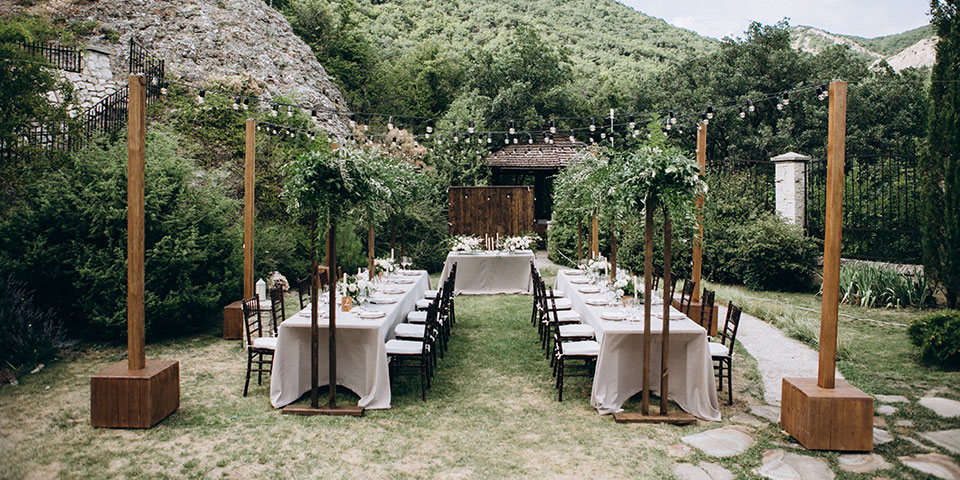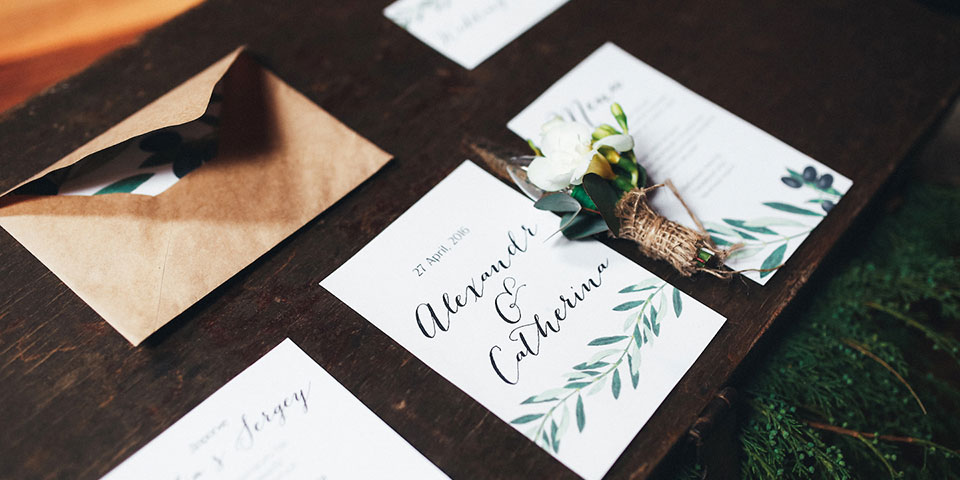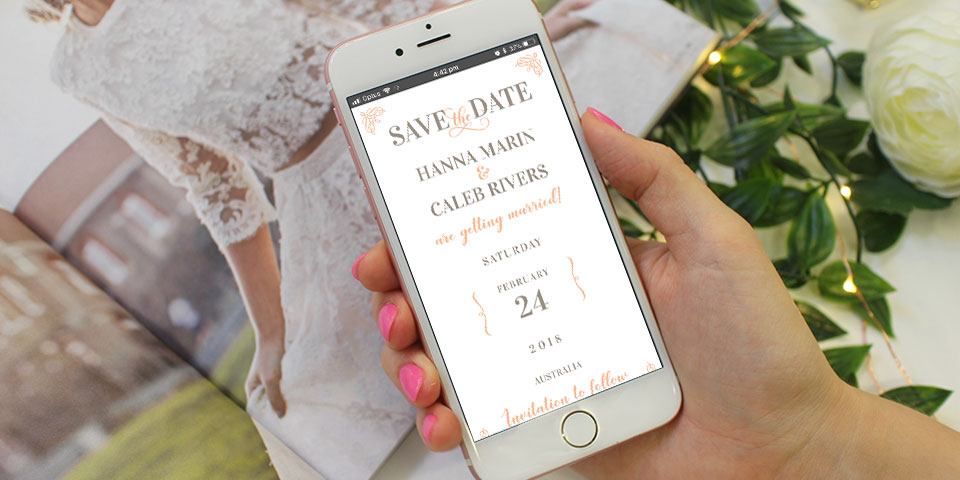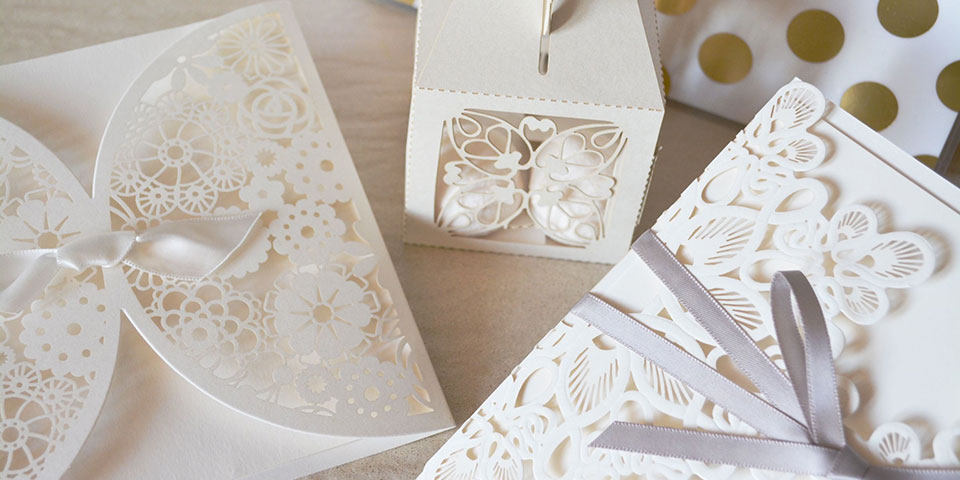Sending your wedding invitations might seem like a straightforward task, but it’s worth taking the time to get them just right. Not only do you need to provide your guests with the essential info they need for the day, but you’ll also want to set the right tone and expectations for your event.
If you’re currently getting ready to send your wedding invitations and looking for a step-by-step guide to follow, you’re in the right place.
Keep reading for our expert tips on what to include on your wedding invitations, how to word them to reflect your event, and exactly when to send them to avoid any stress!
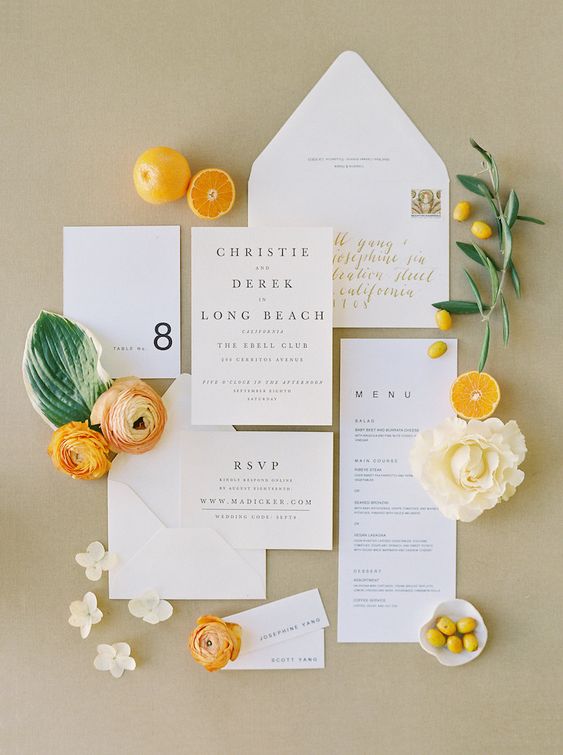
Wedding Invitation Breakdown: What To Include
Let’s talk first about the essential components a wedding invitation should include. Remember, the purpose of your wedding invitations is to help your guests plan and prepare for your day, while giving them a glimpse into the kind of party you’ll be hosting.
With this in mind, a wedding invitation will generally feature the following key elements:
The Rosts
These days, we’ve moved further away from the traditional notion of the bride’s parents hosting the wedding, so this one is optional. However, if you’re hosting a more formal affair (or if your parents are footing the bill!) then you may wish to include their names on your invitation.
The Request
This is where you’ll include a few words to request the attendance of your guests. Depending on the tone of your wedding, this could be a traditional statement like “request the honour of your presence”, or something more casual like “invite you to celebrate with them”.
The Names of the Couple
Let your guests know who’s getting married! Again, depending on the tone of your event, you can choose to include both first names and surnames, or keep it more informal with first names only. And when it comes to the right order to list your names? There really are no rules – you can go for alphabetical order, or use the combination that best rolls off the tongue!
Wedding Date, Time and Location
This is the essential info your guests will be immediately searching for. You’ll want to state your wedding date (day, month, year) and ceremony start time, along with your venue name and location.
For standard wedding venues, you can simply include the venue name and city (assuming it’s easy to find), but for private properties you should provide the exact address.
Reception Details
Let your guests know what to expect after the ceremony with a simple statement like “reception to follow” or “dinner and dancing to follow”. If your reception is taking place at a separate location, this will also need to be outlined.
RSVP Request
Provide guests with your RSVP method (whether that’s via an RSVP card, email or wedding website) and the date they need to RSVP by. You might want to read our 5 proven tips on getting your guests to RSVP on time here!
Dress Code
Stipulating a dress code isn’t essential, but it can be a helpful guide for your guests. Some examples of dress codes would include smart casual, cocktail or black tie.
Not sure which dress code best fits your wedding? We’ve decoded some of the most popular wedding dress codes here.
Wedding Website Link
If you’ve created a wedding website, you’ll need to provide the relevant link as a prompt for your guests to find additional information. Wedding websites are ideal for sharing extra resources that wouldn’t fit on a standard invitation, such as directions to your venue, gift registry details, transport information, and social media hashtags.
Read our guide on exactly what to include on your wedding website here!
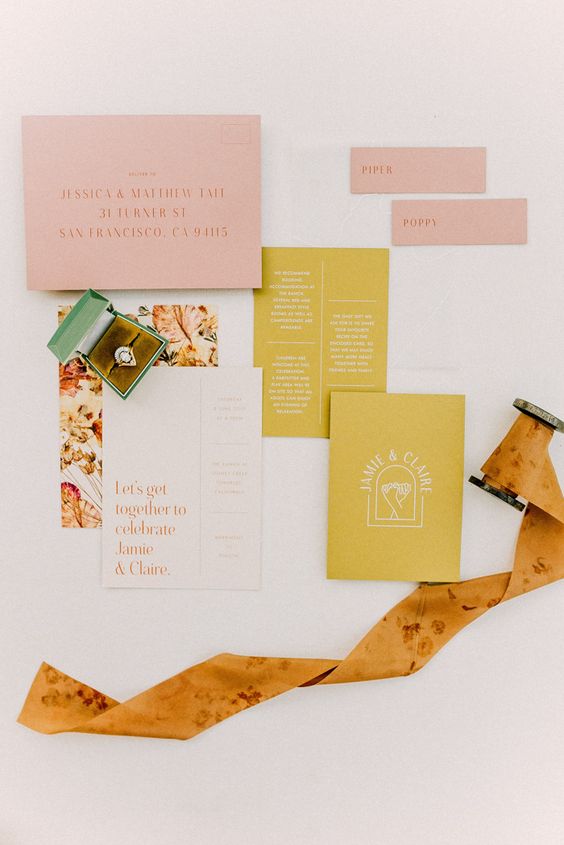
Wedding Invitation Wording Examples in Every Style
So, now that you know exactly what to include on your wedding invitation, let’s talk about wording and verbiage. Your wedding invitations will ultimately set the tone for your upcoming event, so you’ll want to word them appropriately to set the right expectations for guests.
For example: if you’re planning an elegant black-tie affair, it would make sense to use formal, sophisticated language – but a relaxed beach wedding would be better reflected with a casual tone, instead.
Your wedding invitation wording should also reflect your personality, too – if you guys are known for your wild sense of humour, a cheeky and playful tone would make sense to your guests, while a formal tone might not feel authentic. If you’re not entirely sure which wording style would be the best fit for your wedding, take some time to sit down and define your wedding vision first!
Take a look at these wedding invitation samples below to see how different wording styles can be used to set the mood for your celebration.
Formal Wedding Invitation Wording
Formal wedding invitation wording is often used for formal weddings. This style of wedding invitation can be created by following these guidelines:
- Third person language used throughout
- Parents names included as hosts
- Couple specified using both first names and surnames
- Wedding date, time and venue spelled out in full – no abbreviations
- Dress code specified
- A sophisticated and formal tone
Traditional wedding invitations tend to be longer and more detailed than the more modern wording alternatives. See how this looks in action with these traditional wedding invitation wording examples below:
Mr and Mrs Smith
and Mr and Mrs Leo
request the honour of your presence
at the marriage of their children
Matilda Smith and Harrison Leo
Saturday, the seventeenth of June
Two thousand and twenty
at five o’clock in the evening
Plantation Restaurant
Ten Botanical Drive, Palm Beach
Kindly reply by Saturday, the fifteenth of May
Black tie optional
__
Together with their families,
Matilda Smith and Harrison Leo
invite you to join them as they exchange vows
on Friday the fifth of November,
Two thousand and twenty
at three o’clock in the afternoon
The Royal Church, Fitzroy
Reception to follow
Kindly reply by Friday the third of October
Formal dress
__
Mr and Mrs Smith
and Mr and Mrs Leo
Request the pleasure of your company
at the marriage of their children
Matilda Smith and Harrison Leo
Saturday, the twenty first of February
Two thousand and twenty
at half past six o’clock in the evening
Regal Plaza, Fortitude Valley
The favour of your reply is requested at (wedding website link)
Black tie optional
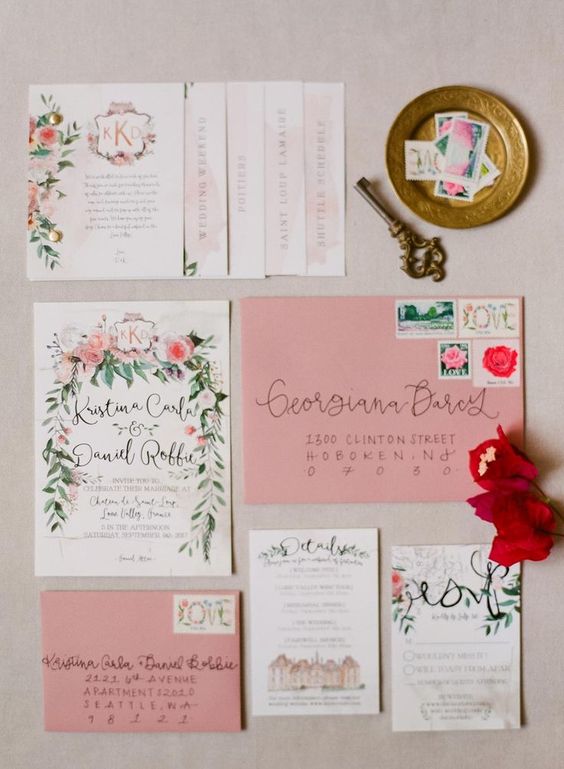
Modern Wedding Invitation Wording Examples
A modern wedding invitation wording style has become increasingly popular over the years, and tends to suit most weddings today. This style of invitation wording is more simplistic and relaxed, and can be created using the following characteristics:
- First person language (“we”, “us”) can be used for a more personal feel
- Surnames are not required
- Wedding date and time can be abbreviated
- Informal language used throughout
See how this looks in action with these modern wedding invitation wording examples below:
We’re getting married!
Sally & Simon
Please join us at
Panorama Terrace, Gosford
9th October, 2020
at 3.30pm
Reception to follow
RSVP by 9th September
Visit our wedding website for more details: (wedding website link)
__
Sally & Simon
invite you to celebrate with them
on their wedding day
10 July, 2020
at 5pm
Stevenson Hall, Currumbin
Festivities to follow!
Please RSVP by 10 June
Cocktail attire
__
Sally & Simon
are tying the knot!
Please celebrate with us
15.07.2020
at 4pm
Mt Woodridge Winery, Ascot
Drinks and dancing to follow
For RSVP and venue details, please visit: (wedding website link)
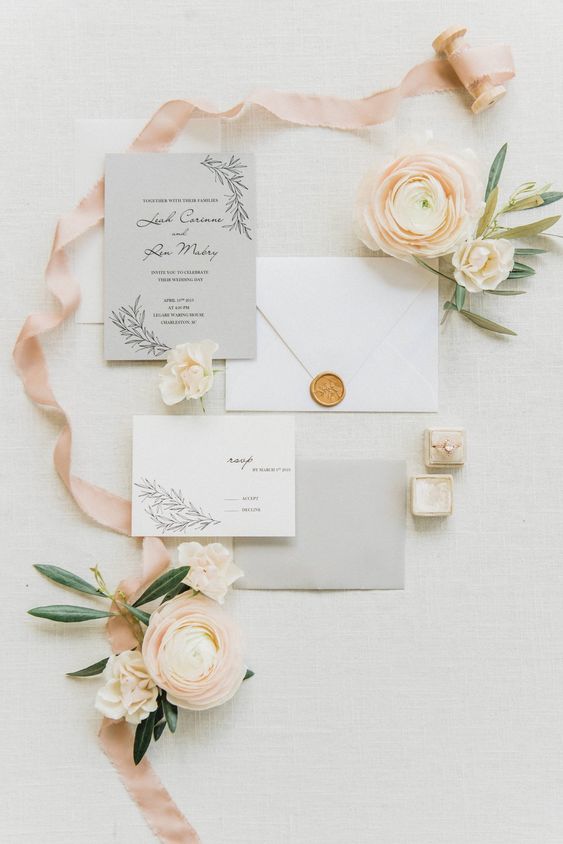
Funny Wedding Invitation Wording Examples
Set the tone for a fun-filled event by injecting a sense of humour into your wedding invitations! This style of wedding invitation wording works best if it genuinely reflects your personality and suits the tone of your celebration. A humorous wording style can be created with:
- Nicknames and abbreviations
- A casual and playful tone used throughout
- Puns, jokes and witty banter welcomed!
Draw some inspiration from these funny wedding invitation wording examples below:
Jim & Jemma
are gettin’ hitched!
(finally)
Join us at 4pm
The Shady Palm, Bendigo
Drinks, dancing and merriment to follow
For more details: (wedding website link)
__
What are you doing on Friday 3rd June at 5.30pm?
Nothing? Perfect!
Then get yourself to
The Boat Shed, Byron Bay
for the wedding of
Jim & Jemma
RSVP and reception details can be found here:
(wedding website link)
__
Good food, great music,
and bad dancing
Jim and Jemma
invite you to party with them
on their wedding day
7 November 2020
at 3pm
Alpine Lodge, Maleny
Shenanigans to follow
RSVP here: (wedding website link)
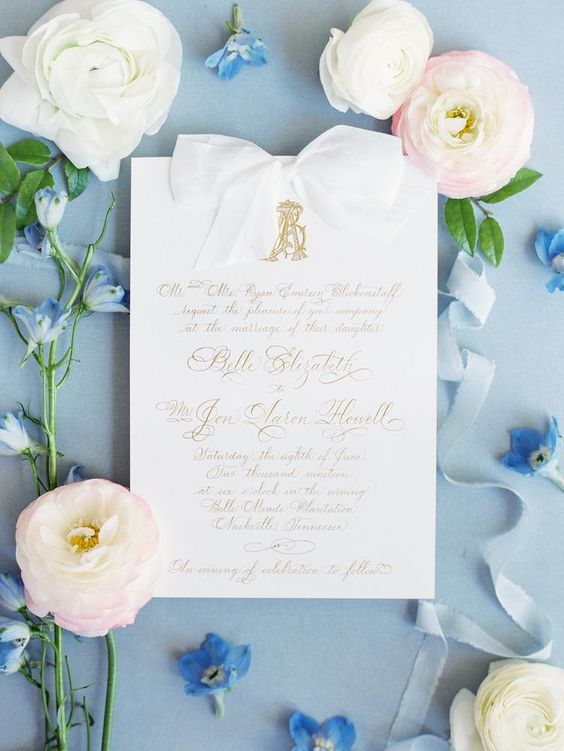
When Should You Send Your Wedding Invitations?
Along with nailing your wedding invitation wording, getting the timing right is also crucial! Send them too early, and your guests may end up forgetting about the day – but send them too late, and you’ll be under some serious stress as you try to finalise your numbers.
So where exactly is the sweet spot? We recommend sending your wedding invitations anywhere between 6-10 weeks before the day.
If you’re worried about guests being able to attend, you can always send out “save the date” cards around the 6-month mark to give friends and family the heads up.
Planning a destination wedding? You’ll need to give your guests a longer lead time so they can prepare for their trip. We recommend sending out destination wedding invitations anywhere from 3-6 months before the day for an interstate event, or up to 10 months for an overseas celebration.
And what about those pesky RSVPs? For peace of mind, we suggest setting your RSVP deadline at least 3-4 weeks prior to your event. This will give you enough time to chase those last-minute stragglers (or, set up an automated RSVP system to do this on your behalf!).
Bonus Wedding Wording Examples
Now that you’ve crafted the perfect wedding invitations, what next? We’ve got you covered with these super helpful wording examples for your wedding website, RSVPs and more:
